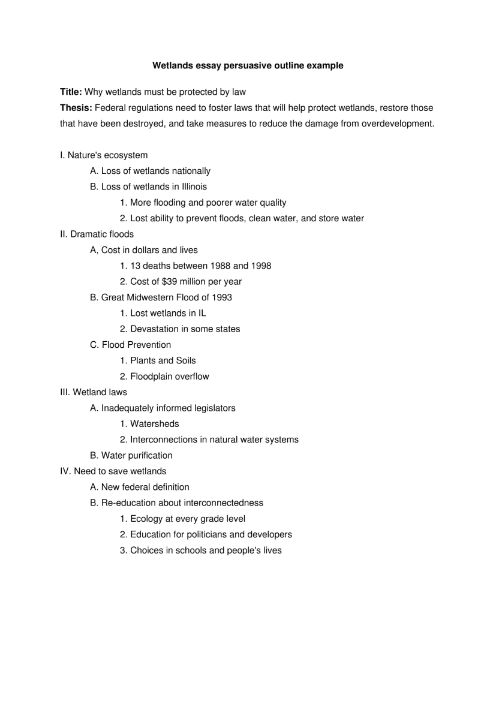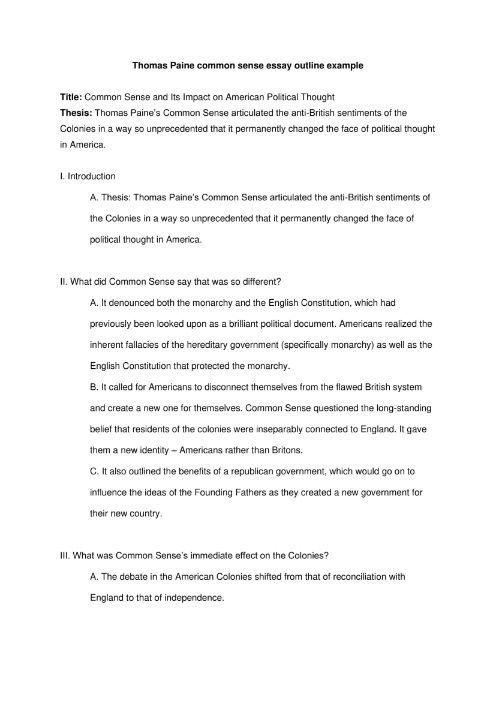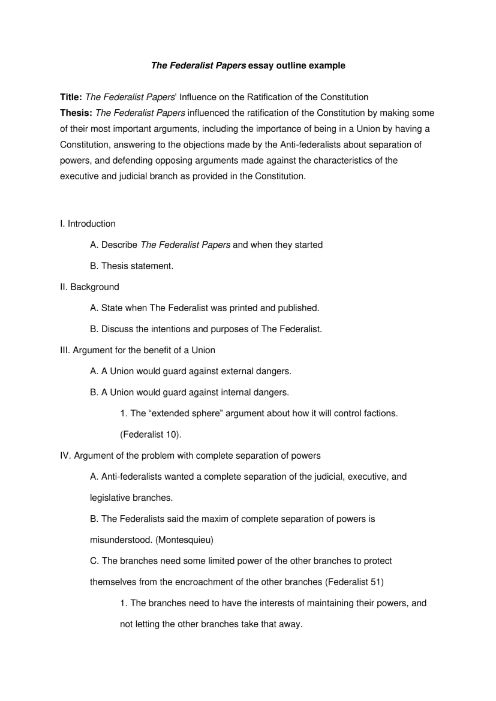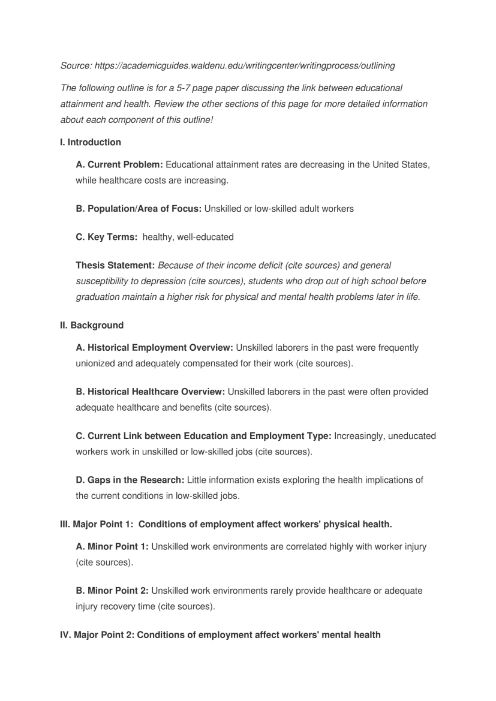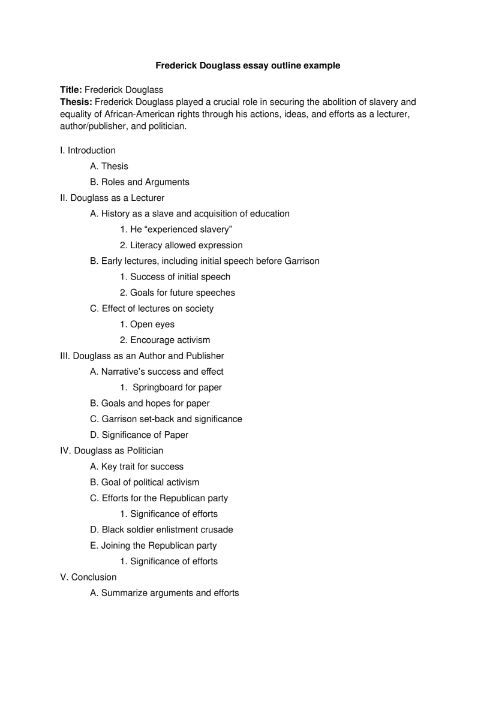Essays are a way to share thoughts or opinions on specific topics. They are often one of the first assignments given to students in elementary school. Additionally, essays are a common method for evaluating students across various subjects, particularly in college. Many schools and even employers may ask for an essay from applicants as part of their selection process.

The silver lining is that many students have a working knowledge of how to write an essay and its structure composition, which usually includes an introduction, body, and a concluding paragraph. Still, the average student spends more than the necessary number of hours on a single task because they run out of ideas or lose their train of thought. Even the overall content of the paper suffers. That can be avoided by penning down a solid outline before writing the first draft. Did you know even seasoned bestseller writers do this? So, what’s an outline? How does it improve your essays, and how do you write it? We are answering all these questions in our guide.
Essay Outline Format and Definition
An essay outline acts like a map or blueprint, guiding writers in organizing their work. It’s similar to a table of contents in research papers and dissertations. Many students actually make outlines without realizing it, which is why learning to write one is straightforward. Typically, students brainstorm and research ideas before starting to write. However, they often don’t organize these ideas properly. This step is crucial to transform their initial thoughts into a structured essay outline.
If writing an effective outline isn’t a task that you must submit for a grade, then it’s up to you how you format it. However, you should follow four main principles when creating a plan for your academic writing:
- Ranking — as you go from your main headings to subheadings, you move from general to more specific.
- Parallelism — every heading on the same hierarchy level should start with the same word type (verb, adjective, noun, etc.).
- Parity — all headings of the same hierarchy should be equally important and less important than the ones higher in rank.
- Fragmentation — each main heading should be divided into at least two subheadings.
The image below illustrates all four principles of outlining:
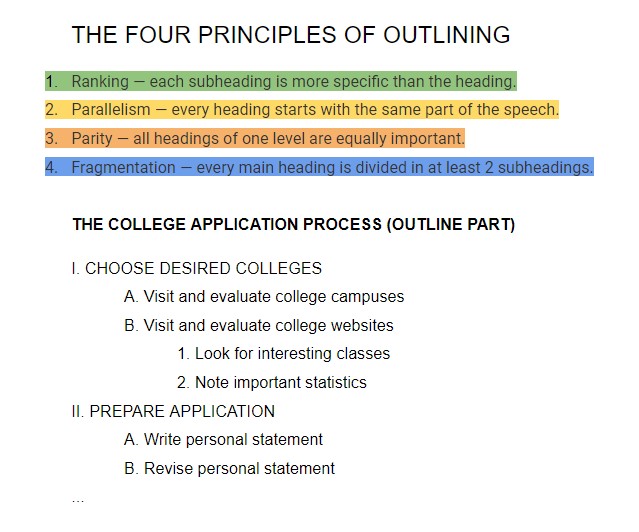
The most popular format is a standard outline template that uses letters and numbers. The headings are organized in a specific order, starting from the main title and going down to the more detailed sections.
- I. Roman numerals
- A. Capitalized letters
- 1. Arabic numerals
- a. Lowercase letters
- (1) Arabic numerals in round brackets
- (a) Lowercase letters in round brackets
- (1) Arabic numerals in round brackets
- a. Lowercase letters
- 1. Arabic numerals
- A. Capitalized letters
For what you write in each point, you can use brief phrases or full sentences to summarize the idea.
The decimal outline structure is another format you can apply, and it looks like this:
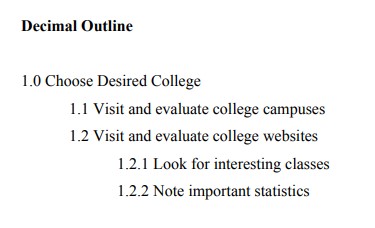
When organizing an essay, there are two primary types of outlines: topic outlines and sentence outlines.
A topic outline lists your essay’s main points and subpoints in short phrases or single words. As a result, it provides a clear, concise structure and helps you visualize the flow of the essay without getting into detailed sentences. This type of outline is mainly useful for shorter essays or when you have a strong comprehension of the subject and do not need to go into every point during this initial planning stage.
In contrast, a sentence outline has complete sentences for each main point and subpoint. This outlining approach offers a more detailed framework, allowing you to flesh out your ideas and ensure that each part of the essay is developed well. Sentence outlines are good for longer or more complex papers, where you need to clarify your thoughts and arguments in advance. By using full sentences, this outline type helps identify any gaps in logic or areas that need further analysis, making the actual writing process smoother and more efficient in the end.
Why is Outlining Important?
Reasons vary, but we usually use it to logically order all the data you collected during the brainstorming and researching stages. A good outline helps a lot in writing research papers, as you can easily keep track of all the relevant information. Even for oral presentations, it’s a great way to identify the strengths and weaknesses of their speech and make it more effective. To sum up, an outline’s core functions are:
- Guiding you during the writing phrase
- Helping you organize your thoughts and ideas
- Presenting material in a logical order
- Showing how your ideas link to one another
- Serving as an abstract for your paper
Outlines enhance thinking flow
Consider planning every next day before going to bed. You will realize that you undertake your daily activities without overthinking or second-guessing yourself because you know what to do every time. That is one of the proven life principles for most successful people. The same applies to paper writing. Your essays will feel like a walk in the park if you outline every major point beforehand.
Outlines save time
Time is a commodity that none of us have in abundance, especially considering the responsibilities students have to undertake daily. So why spend hours on essays when you have mounting academic work? You’d rather waste less time and still get good grades. That’s what essay outlines are for: saving time and improving your performance. Once you’ve planned out your essay, it takes less time to develop each idea.
Outlines improve grades
From students’ perspective, the whole point of sweating over an essay is to get the best grades, and an outline can help you do that. If you take time to brainstorm and jot down every major point you can raise in your essay, you will make fewer errors. If you arrange your ideas in an order that makes sense, your tutor will notice it and evaluate the paper accordingly.
How to Outline an Essay
Building an outline is an excellent way to ensure that every paragraph in your essay has a purpose. While outlining, you can see if a paragraph is essential or can be dropped without harm to your paper. It also checks how your argument or main idea is advancing, which will help you speed up the proofreading stage. Now that you learned how significant outlining is, let’s see how you can create one.
Before writing an outline, you should:
- Define the goal of your essay.
- Determine the target audience.
- Create the thesis statement.
Step 1: Research
The quality of your research determines the quality of your outline and your essay at large. That includes finding quotes from reputable sources or indicating the main supporting points to bolster your argument. Depending on your educational background, you might have to use different sources to expedite your research.
Any websites found on Google are unsuitable sources for papers written at a college or university level. Since the Internet is full of unverified information, it’s vital to ascertain your source’s credibility before referring to it. Examples of trusted sites include Google Scholar, Microsoft Academic, Science.gov, Refseek, and Oxford Academic.
Step 2: Organize
After choosing a topic and researching, it’s time to write the outline using all the gathered information. It should match the layout of the essay: an introduction, a body section, and a conclusion. Have you ever written down something but couldn’t read from your handwriting later on? This usually happens if you have bad handwriting or the information is too clustered to read. You don’t want to rely on such an outline, especially when pressed for time. So, you must organize your plan to match the essay structure.
Introduction
Some ways to start your introduction paragraph are anecdotes, proverbs or idioms, definitions, statistics, quotes, or facts. You can begin your essay outline by jotting down the main ideas for the introduction, which should also include a thesis statement. The point is to equip yourself with a road map, so short sentences should suffice.
Body paragraphs
Each body paragraph provides one idea that supports your thesis statement and is backed by facts, details, and examples. There will be more or fewer paragraphs here, depending on the essay volume. But, when writing a standard essay, you would usually need three body paragraphs, each of which should be in your outline. Remember that every paragraph must start with a topic sentence supported by two or three independent ideas with a link (transition) sentence at the end.
Conclusion
This paragraph summarizes every major point in the essay with some broader context. For a short paper, three to five sentences should be used for the concluding section of your paper.
Below is an easy-to-follow template for a standard five-paragraph essay outline. You can quickly download it by clicking the button located beneath the image.
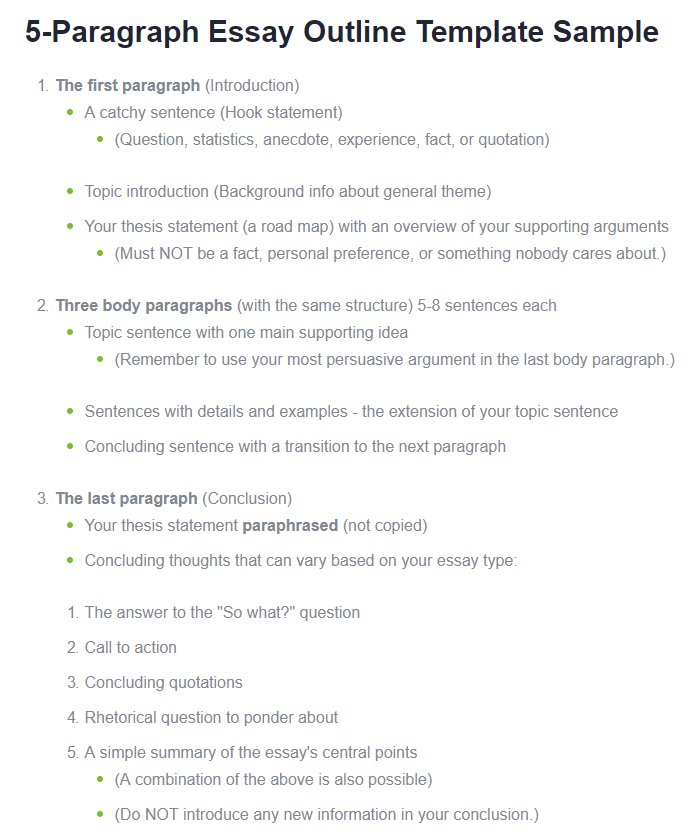
Once you’re done, remember to proofread and edit to ensure you haven’t missed something important.
Essay outline examples
Now that you’ve learned how to create an outline, take a look at the samples below to see how to put this theory into action. Each essay outline has been carefully selected to highlight the essential principles of effective outlining.
CLICK OR TAP ON THE IMAGE TO DOWNLOAD IT IN PDF
Argumentative essay outline example
Similar to persuasive essays, argumentative essays are designed to persuade the reader to accept a specific point of view. They require the writer to use relevant evidence and reasoning to support their arguments while addressing and refuting opposing viewpoints.
An outline for an argumentative essay on “The Importance of Renewable Energy” could be organized in this way:
- I. Introduction
- A. Start with a striking statistic about current global energy consumption.
- B. Provide background on the reliance on non-renewable energy sources.
- C. Thesis: “In the face of escalating environmental crises and depleting non-renewable resources, transitioning to renewable energy sources emerges as an indispensable solution, not only to mitigate ecological damage but also to ensure long-term sustainability and economic viability for future generations.”
- II. Body Paragraphs
- A. Point I: Environmental Impact of Non-Renewable Energy
- 1. Detail the ecological damage caused by fossil fuels.
- 2. Highlight the contribution of non-renewable energy to global warming.
- B. Point II: Benefits of Renewable Energy
- 1. Describe the long-term environmental benefits of renewable sources.
- 2. Discuss technological advancements in renewable energy.
- C. Counterargument: Cost and Feasibility of Renewable Energy
- 1. Address concerns about the high cost and practicality.
- 2. Provide evidence of decreasing costs and increasing efficiency.
- A. Point I: Environmental Impact of Non-Renewable Energy
- III. Conclusion
- A. Reiterate the thesis in light of the arguments presented.
- B. Summarize the environmental and economic benefits.
- C. Concluding statement: Call to action for policy changes and individual responsibility.
Narrative essay outline example
Narrative essays tell a story, focusing on personal experiences and emotions. For instance, a narrative essay titled “My Journey to Becoming a Volunteer” could have the following example outline:
- I. Introduction
- A. Open with a personal anecdote about the desire to help others.
- B. Set the scene for the volunteer journey.
- C. Thesis: “My journey to becoming a volunteer was a transformative experience that reshaped my understanding of community and self, teaching me invaluable lessons in empathy, resilience, and the profound impact of selfless service on both personal growth and the well-being of others.”
- II. Body Paragraphs
- A. The Decision to Volunteer
- 1. Describe the initial motivation and decision-making process.
- 2. Mention key influences or events leading to the decision.
- B. The Volunteering Experience
- 1. Narrate specific experiences and interactions during volunteering.
- 2. Reflect on challenges faced and how they were overcome.
- C. Lessons Learned and Personal Growth
- 1. Discuss the skills and insights acquired.
- 2. Illustrate how the experience changed perspectives on community and self.
- A. The Decision to Volunteer
- III. Conclusion
- A. Summarize the journey and its impact.
- B. Reflect on the personal changes and growth experienced.
- C. Closing thoughts: The ongoing importance of volunteer work.
Compare and contrast essay outline example
Compare and contrast essays examine the similarities and differences between two subjects, offering a balanced view. For example, a compare and contrast essay on “Online Learning vs. Traditional Classroom” might follow this outline:
- I. Introduction
- A. Discuss the rise of online learning platforms.
- B. Contrast online and traditional classroom settings.
- C. Thesis Statement: “While both online learning and traditional classroom education aim to deliver quality education, they differ significantly in terms of their learning environments and teacher-student interactions, each offering unique advantages and challenges that cater to diverse learning needs and preferences.”
- II. Body Paragraphs
- A. Similarity: Educational Content
- 1. Compare the curriculum and teaching materials used in both settings.
- 2. Illustrate with examples of course content in both formats.
- B. Difference I: Learning Environment
- 1. Detail the virtual setting of online learning vs. physical classrooms.
- 2. Discuss the impact of these environments on student engagement.
- C. Difference II: Teacher-Student Interaction
- 1. Compare the nature of interactions in online and traditional settings.
- 2. Examine the impact on student learning and participation.
- A. Similarity: Educational Content
- III. Conclusion
- A. Recap the key similarities and differences.
- B. Reflect on the effectiveness of each mode of learning.
- C. Final thoughts: Future trends in education.
Bottom line
Here are three key tips for students creating essay outlines:
- Review Your Assignment: Start by thoroughly reading your assignment instructions. This helps you understand your essay type and any word count limits.
- Keep Your Title and Thesis Handy: At the top of your outline, write down your essay’s title and the full thesis statement. This keeps your main idea in clear view as you work.
- Take Notes During Research: As you research, jot down key points. These notes will be valuable when you’re building your essay outline.
Remember, essays vary widely, from argumentative and narrative to comparative and persuasive, each with its own goals and structure. Mastering the art of outlining is crucial for improving your writing skills and achieving higher grades. If you often struggle with organizing your thoughts or experience writer’s block, planning your essay before you start writing can be immensely helpful. With practice, you’ll be able to complete your assignments more quickly while maintaining high quality.
Mini-FAQ
The earlier, the better. If you start researching without note-taking and creating an outline, you might do all that research in vain. You need to read a bit, find reputable sources that you will use, and analyze the evidence before planning. But, as soon as your argument starts shaping, you should start putting your thoughts on paper.
Planning is a bit individual. Some people benefit from it more than others. If you can generate ideas easily but struggle with the writing process, preparing a thorough outline will help. Conversely, if you’re having a hard time coming up with ideas, you might benefit more from writing right away. Overplanning can also be harmful when it doesn’t leave enough time to complete the paper.
References
- Walden University — Outlining
- Bow Valley College — Writing Support
- Purdue University — Types of Outlines

